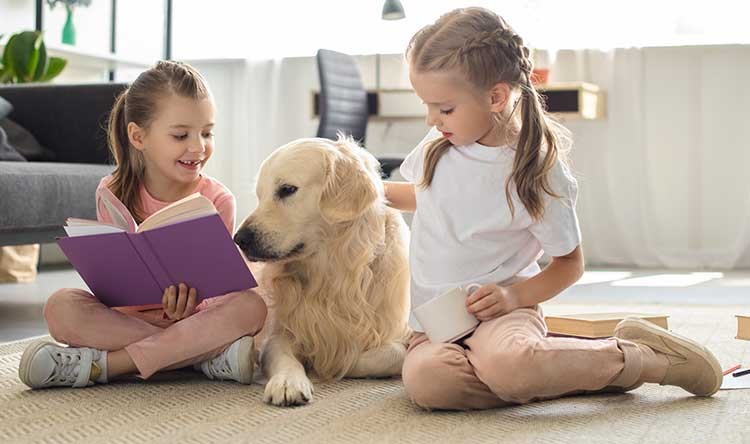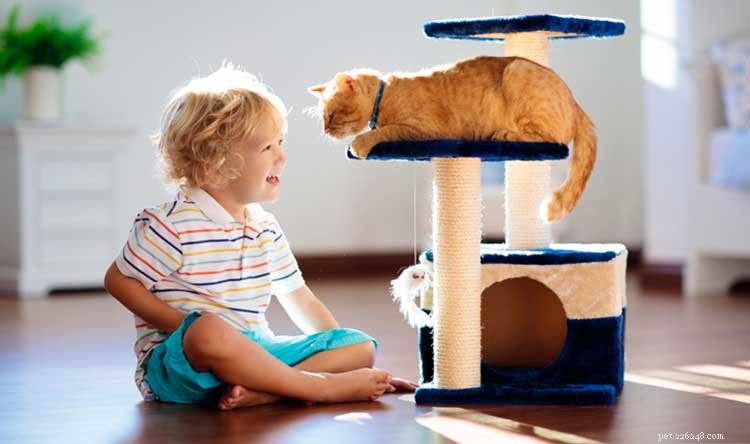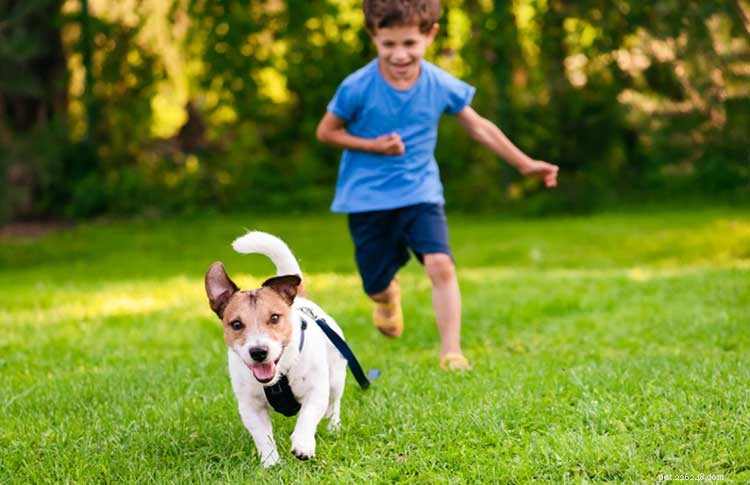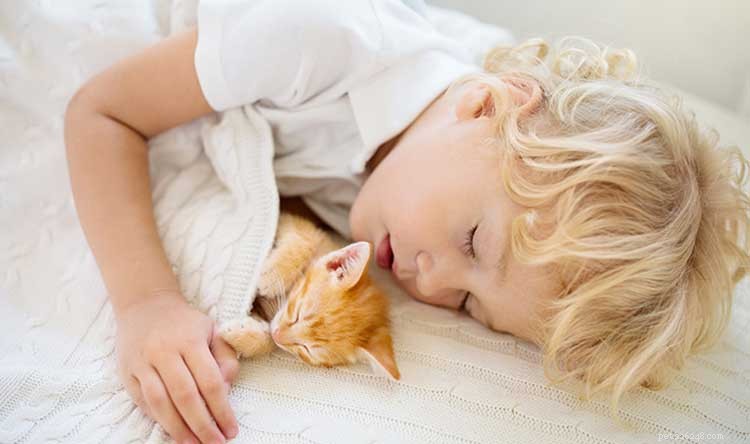Principaux plats à emporter
- Les enfants bénéficient grandement d'avoir un animal de compagnie, mais il est essentiel de choisir le bon type d'animal de compagnie et de le présenter correctement.
- L'adoption d'un chien ou d'un chat dépendra du niveau d'énergie de votre famille et du temps dont vous disposez pour vous occuper d'un animal domestique.
- Quel que soit l'animal que vous adoptez, la clé est de préparer votre famille à l'avance et de faire les présentations lentement et soigneusement.

Ainsi, vos enfants sont assez grands pour aimer avoir un animal de compagnie et ont mendié pour en avoir un .
Faut-il adopter un chien ou un chat ? Comment gardez-vous les enfants en sécurité? Comment leur enseignez-vous la responsabilité de posséder un animal de compagnie ?
Nous avons demandé conseil à Sarah-Anne Reed, dresseuse de chiens holistique et propriétaire de Pack Dynamics LLC.
Comment savoir si mon enfant est prêt à avoir un chien ?
Votre enfant doit être assez âgé pour comprendre et suivre les instructions concernant l'interaction avec votre chien et la prise en charge de celui-ci. S'ils ne sont pas d'accord avec la formation et ne suivent pas vos signaux, l'incohérence peut causer beaucoup d'anxiété pour vous, entraînant des problèmes de comportement chez votre chien.
Si votre enfant a encore des effondrements extrêmes, comme des coups de pied, des cris, des coups ou des lancers d'objets, ce n'est pas un environnement confortable et sûr pour amener un chien et cela pourrait le rendre craintif. Lorsque les chiens ont peur, ils sont susceptibles de grogner ou de pincer la personne dont ils ont peur, ce qui pourrait facilement conduire à une morsure de votre enfant. Cela ne signifie pas que le chien est agressif, mais simplement qu'il doit être dans une maison sans enfants.
Votre enfant est prêt à avoir un chien s'il :
- Peut écouter et suivre les instructions.
- Sachez comment exprimer votre anxiété ou votre colère de manière saine, sans crier ni frapper.
- Avoir démontré qu'il peut être doux, gentil et aimant envers les animaux.
- Avoir une compréhension réaliste de ce que signifie prendre soin d'un chien.

Comment savoir si mon enfant est prêt à avoir un chat ?
Les chats sont beaucoup moins responsables pour un enfant. Ils n'ont pas besoin d'être promenés ou entraînés et sont assez autonomes. Un chat peut être un excellent ami d'enfance, surtout s'il est affectueux et aime se blottir sur vos genoux. Un chat peut être l'animal de compagnie idéal pour les jeunes enfants afin de leur apprendre des responsabilités, comme nourrir votre chat, le brosser et nettoyer sa litière.
C'est aussi une excellente occasion d'enseigner à votre enfant la manière appropriée de donner de l'affection à un animal. Leur apprendre à ne pas leur tirer la queue, à bien les caresser, à leur parler avec gentillesse et à toujours montrer de l'amour. Il est essentiel de s'assurer que vous choisissez le bon tempérament lorsque vous adoptez un chat, car tous les chats n'apprécient pas l'affection ou ne se sentent pas à l'aise avec les enfants. Passez du temps avec le chat avant de prendre la décision de ramener un nouveau membre de la famille à la maison.
Quelles sont les différences entre présenter un chien ou un chat à mon enfant ?
Présenter les chats aux enfants
Introduire un chat dans votre maison est un processus beaucoup plus facile qu'un chien. Plus l'environnement est calme, plus il sera confortable pour votre nouvel animal de compagnie de s'adapter à sa nouvelle maison et à sa nouvelle famille. Lorsque vous présentez un chat, laissez-le d'abord explorer lentement sa nouvelle maison et montrez-lui sa litière. Le changement pour les chats peut être difficile et créer de la curiosité et parfois de la peur, c'est pourquoi il est crucial de les présenter lentement aux membres de la famille. Les enfants peuvent être difficiles pour les animaux car ils sont plus petits, leurs mouvements sont plus imprévisibles et leur son et leur comportement sont différents de ceux des adultes.
Lorsqu'un chat a peur, il peut siffler ou gratter, ce qui peut être effrayant pour un enfant. Ils pouvaient aussi recourir à la clandestinité. Aucune de ces réactions ne crée une expérience heureuse pour votre chat ou votre enfant.
Assurez-vous que votre famille est détendue et présentez lentement le chat à chaque membre de la famille, un à la fois. Demandez à votre enfant d'appeler le chat vers lui et laissez d'abord le chat renifler sa main, puis offrez-lui des friandises. Si le chat s'approche et semble à l'aise avec votre enfant, demandez-lui de le toucher doucement, pendant que vous le guidez et l'encouragez.
Conseils :
- Il est préférable d'avoir plusieurs interactions courtes avec votre chat afin de ne pas lui mettre trop de pression.
- Ne forcez aucune interaction. If your cat doesn’t want to be held or touched, respect that they may need more time to settle in.
- Take baby steps until you have created a comfortable experience for both the cat and your child.
Introducing dogs to children
Introducing a dog to your child can be much more involved. Before ever deciding to get a puppy or adopt a dog, always have your child meet the dog first to see how they interact with each other. If you are thinking of adopting a dog, many dogs have had bad experiences with children or adults in their past, which can cause them to be wary and nervous with children and people in general. I do not recommend adopting a dog who shows any anxiety or fear with your child, as it can take months or even years to help a dog overcome fear, no matter how kind your child is.
Once you have determined that the puppy or rescue dog will be a good match for your family and lifestyle, it’s a good idea to bring something familiar into your home to help them adjust. You can bring their dog bed, a blanket, and toys that will be comforting to them. Set up everything for your dog so that they start to learn where their water bowl is and can go to their familiar dog bed or grab their toy if they need some familiar comforts.

The introduction step-by-step:
- The best way to introduce a dog to your child is to sit them in a chair beside you as the dog is walked into the room by another adult with a slack leash. It’s vital that the dog and child be as calm as possible before they meet giving them the best opportunity for success.If the dog walks ahead of the person on leash, the handler turns around to walk in the opposite direction a few steps, then waits 30 seconds before walking back into the room.
- Repeat bringing the dog in until he is calmly walking beside the person without any eye contact or talking as they are being walked into the room. Be sure no one is looking at the dog or talking to them, to help the dog feel relaxed, with no pressure.
- The person holding the leash sits in a chair across the room from the child, and everyone continues ignoring the dog until he settles down and stops trying to get everyone’s attention. Once the dog has been calm for five minutes, you can drop the leash, and then the child can call the dog over for affection in a relaxed, friendly tone. Be sure the child is sitting with their body facing away from the dog, so as not to loom over them when they approach for attention and offer a treat, with the palm of their hand facing up.
- Once the dog feels comfortable accepting the treat, the child can reach down with one hand and slowly pet them on their chest first, never over their head, as that can make a dog feel uncomfortable. If the dog appears to feel safe and relaxed, they can rub the back, rump, and tummy.
Taking these additional steps will help your dog learn how to calmly interact with your child and teach your child to be kind and gentle to your dog. Your dog has emotions too and can feel nervous or uncomfortable. It’s wise to keep the leash attached to the dog for a while, just in case you misjudged their reaction, you can easily remove the dog from the room if you need to.

What can I do to prepare my child ahead of adopting a dog or cat?
Discussing the responsibilities
Talk to your children before adopting a dog or cat and explain the additional help you will need from them. Your children should feel included in the process and understand that this is a life-long commitment.
Take a “trial run” by pet sitting
It’s a great idea to dog sit for at least a week for a friend or family member to give a real-life experience to your child about the reality of having a dog. Include them in feeding the dog, teaching them how to brush the dog, give affection and play appropriately and take your child along during walks.
Playing with a dog sounds fun, but are they willing to help take the dog out to eliminate, and do the necessary “poop patrol,” even when it’s a cold or a rainy day?
You can also cat-sit if you are planning on getting a kitty to teach your child about the responsibilities of having a cat, like cleaning the litter box, feeding, and brushing them. It’s also essential to teach them how to appropriately play with and give affection to the cat. If you don’t know anyone you can dog- or cat-sit for you could foster for a week. This not only gives you a tremendous real-life experience and also allows you to see if the pet is a good fit for your family and lifestyle.
Is there any other advice you could give to parents wanting to bring a dog or cat into the household?
If you feel like you are already juggling too much in your life, know that having a dog often feels like having another child. Dogs have different needs than children, but if you don’t have the time and patience to dedicate to training and their care as a family, it’s not a good idea to bring a dog into your home as you will feel even more overwhelmed. A cat may be a better option for busy parents, as they require much less time and attention and don’t need training, but still allow your child to learn about the responsibility and joys of caring for and loving an animal.
I do not recommend asking your children to walk your new puppy or dog until you have mastered heel training. Most adults have difficulty walking an untrained dog and a child could easily get hurt, or the dog could get loose and run away or get injured. Once your dog knows how to heel it’s advisable that you walk your dog with your child for a while until your child feels confident and you trust your child to handle every situation that may happen during a typical walk. If your dog reacts to other dogs, either wanting to play with them or nervous when they see another dog, this can be too much to handle for most children, depending on their age.
Sarah-Anne Reed is a holistic dog trainer, and owner of Pack Dynamics, LLC ®. Her practice focuses on understanding and respecting dogs as a different species and honoring them as individual beings.
This article is copyrighted by Sarah-Anne Reed and Pack Dynamics ® LLC, and no reproduction of this article without the express permission of Sarah-Anne Reed is permitted.
Are you thinking about getting a new pet? Then you are a great candidate for pet insurance. Get a quote and make sure you’re covered for future injuries or illnesses.